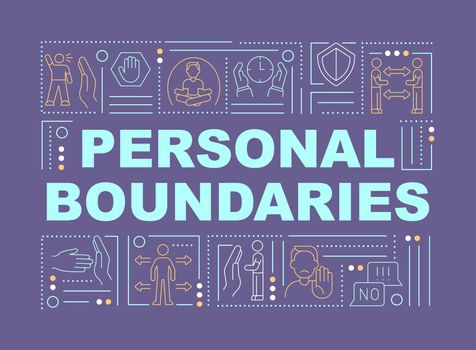The boundary to what we can accept is the boundary to our freedom.
– Tara Brach
Setting boundaries in your personal and professional life involves establishing clear guidelines and limits on how you want to be treated, what you are willing to do or not do, and how you allocate your time, energy, and resources.
Setting boundaries in both your personal and professional life is crucial for several important reasons:
👉 Self-care: Setting boundaries allows you to prioritize your own well-being and self-care. It helps you avoid overextending yourself and prevents burnout. By setting limits on your time, energy, and resources, you can ensure that you have enough for yourself, which in turn enables you to be more effective and productive in both your personal and professional life.
👉 Respect: Boundaries demonstrate self-respect and set the tone for how you expect others to treat you. By setting clear boundaries, you communicate your values and expectations, which encourages others to respect your needs, opinions, and personal space. This helps foster healthy relationships, both personally and professionally, based on mutual respect and understanding.
👉 Work-life balance: Boundaries help you maintain a healthy work-life balance. Setting limits on your work hours, not bringing work home, and carving out time for personal activities and relationships can help you maintain a sense of equilibrium and prevent one aspect of your life from dominating the other. This promotes overall well-being and prevents work-related stress from affecting your personal life, and vice versa.
👉 Focus and productivity: Boundaries help you stay focused and productive by eliminating distractions and interruptions. By setting boundaries around your time, tasks, and availability, you can minimize disruptions and stay focused on your priorities. This leads to increased productivity, efficiency, and effectiveness in both your personal and professional pursuits.
👉 Assertiveness and empowerment: Setting boundaries requires assertiveness, which is an important communication skill. It allows you to express your needs, desires, and limits in a clear and respectful manner, which empowers you to take control of your personal and professional life. Assertiveness helps you avoid being taken advantage of or manipulated, and it promotes healthy relationships based on open and honest communication.
👉 Mental and emotional well-being: Boundaries play a significant role in maintaining your mental and emotional well-being. They help you avoid being overwhelmed, manage stress, and prevent conflicts and misunderstandings. By setting boundaries that align with your values, you can create a supportive environment for your personal and professional growth, and ensure that your mental and emotional health are safeguarded.
Steps you can take to set boundaries:
Define your priorities: Reflect on your values, needs, and priorities in both your personal and professional life. Consider what is truly important to you and what you want to prioritize. This will help you establish a foundation for setting boundaries that align with your values and goals.
Communicate your boundaries clearly: Once you have a clear understanding of your boundaries, communicate them assertively and clearly to others. Use “I” statements and express your needs, preferences, and limits in a respectful and confident manner. Be specific and direct in your communication.
Be consistent: Consistency is key in maintaining boundaries. Follow through on the boundaries you set and be consistent in enforcing them. This may require saying “no” when necessary or declining requests that do not align with your boundaries. Avoid making exceptions that can undermine the effectiveness of your boundaries.
Prioritize self-care: Setting boundaries often involves prioritizing self-care. Make sure to set aside time for yourself, to recharge, and to take care of your physical, mental, and emotional well-being. This may mean scheduling regular breaks, setting limits on work hours, or making time for hobbies and activities that bring you joy.
Learn to delegate: In a professional setting, learn to delegate tasks and responsibilities to others when possible. Avoid taking on more than you can handle and be willing to delegate tasks that can be handled by others. This helps prevent overload and allows you to maintain a healthy work-life balance.
Be mindful of your time and energy: Be mindful of how you spend your time and energy, and set boundaries accordingly. Learn to say “no” to activities, commitments, or relationships that drain your energy or do not align with your priorities. This will help you protect your time and energy for what truly matters to you.
Anticipate and prepare for challenges: Setting boundaries may face challenges or pushback from others. Anticipate potential challenges and be prepared to respond assertively and respectfully. Stay firm in your boundaries and be ready to reinforce them when necessary.
Seek support: Setting and maintaining boundaries can be challenging. Seek support from trusted friends, family, or mentors who can provide encouragement, guidance, and accountability. Having a support system can make it easier to establish and maintain boundaries in your personal and professional life.
Remember that setting boundaries is a continuous process and may require ongoing effort and adjustment. It’s important to be kind to yourself, be patient, and stay committed to taking care of your well-being by establishing and maintaining healthy boundaries.
Some examples of setting boundaries in both personal and professional life:
Personal life:
– Setting a boundary on your personal time by carving out specific time slots for self-care activities such as exercise, hobbies, or relaxation, and communicating to others that these times are off-limits.
– Establishing boundaries on social media and electronic devices, such as limiting screen time, turning off notifications during specific times, or designating device-free zones in your home.
– Setting limits on your availability for social events or gatherings, and being assertive in declining invitations or requests that do not align with your priorities or values.
– Setting boundaries with family or friends by clearly communicating your needs, preferences, and limits, and asserting yourself when it comes to issues like personal space, privacy, or emotional well-being.
Professional life:
– Setting clear expectations with your employer or colleagues regarding your work hours, workload, and availability outside of work hours. Communicate your boundaries around after-hours work emails or calls, and ensure that you have designated time for rest and self-care.
– Learning to say “no” when you are overwhelmed with work or when a request is not aligned with your job responsibilities or professional goals. Setting boundaries around taking on additional tasks or responsibilities that may affect your work-life balance.
– Setting boundaries around work-related communication, such as establishing designated times for checking and responding to emails or messages, and avoiding work-related communication during your personal time or vacations.
– Setting physical boundaries in your workplace, such as respecting your personal space, setting limits on interruptions, and communicating your need for focused, uninterrupted work time.
– Setting boundaries around your professional development and career goals, such as communicating your expectations for performance reviews, promotions, or work assignments, and advocating for yourself when it comes to your career advancement.
Remember that the specific boundaries you set will depend on your individual circumstances, values, and preferences. It’s important to reflect on what is important to you and communicate your boundaries assertively and respectfully to others. Setting and maintaining boundaries can help you maintain a healthy work-life balance, reduce stress, and protect your well-being in both personal and professional settings.




